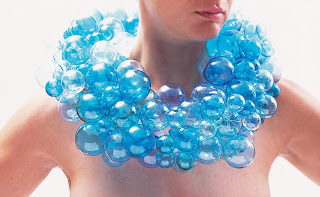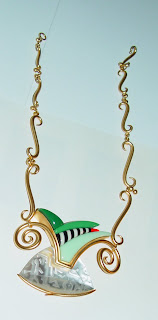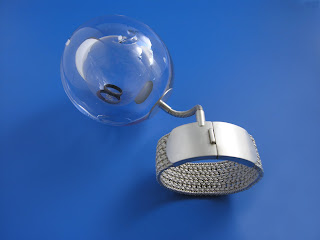GlassWear: All Glass Jewelry Isn’t Created Equally
A funny thing happened while I was previewing the “GlassWear: Glass in Contemporary Jewelry” exhibition (on view from July 15-September 20) at the Museum of Arts and Design, I forgot that the jewelry that I was looking at was all made of glass. This must be a testament to the incredible skill of these artists. They have become so proficient in working with glass that they are able to manipulate in such ways that it resembles other materials. Furthermore, I was too busy concentrating on the beautiful forms, colors and the creative use of these pieces. After all, not all jewelry needs to be worn on your fingers, earlobes and around the neck, they can adorn other parts of out body as well. I believe that the curator’s goal was to demonstrate what a rich medium glass is and how it can be used in different ways to create incredibly diverse pieces of jewelry.
Since this is an exhibition of contemporary jewelry, I am always fascinated to see how artists try to forgo the past yet always wind up referencing it in some way. For example, necklaces by both George Dobler and Linda MacNeil reminded me of Art Nouveau jewelry. Dobler’s “Necklace” (2006) of quartz, glass, and silver is ornamented with two large beetles on both sides, is reminiscent of Rene Lalique’s “Blister Beetle” corsage ornament (ca. 1903-1904) that is now in the Gulbenkian Museum. Lalique’s corsage ornament is also made of glass and silver, along with gold, enamel, and tourmaline. MacNeil’s flower necklaces, including “Foreign Flower” (2003) or “Egyptian Blossom” (2007) are made of acid-polished glass. MacNeil, uses glass as her central component, and like Art Nouveau jewelers, elevates it to the same level as precious and semi-precious stones. Glass was a favorite material of Art Nouveau jewelers because their work was concerned with imagery and vivid colors were needed to translate their vision of peacocks, ivy leaves and flowing hair. And of course, nature was a favorite muse for artists going back to the eighteenth and nineteenth centuries but in the hands of the Art Nouveau artists it was depicted in new ways.
My main complaint about a lot of contemporary jewelry is that is considered to be a “wearable art” and artists forget that jewelry, while it is an art form, is also meant to be worn. Some of the items in the exhibition were more conceptual then practical. Bernhard Schobinger’s “Bottle-Neck Necklace” (1998) that has been made of broken glass bottlenecks, simply looks dangerous. Simsa Cho’s “Aodama” Necklace (2006) made of cast, slumped and enameled glass resembles a piece of sliced agate. Though extraordinarily beautiful, because of its scale, it resembles body armor more than it does a necklace. For some artists, like Cho, the use of glass also has a spiritual meaning. He “believes that body ornaments made of glass can transport positive energy to the wearer.” Ted Noten’s “The Real Love Bracelet” (2005), made of blown glass and features a silver bracelet and gold wedding bands, is another example of attributing meaning to a piece of jewelry. Noten’s idea is that the bracelet has a glass bubble attached to it which contains the wedding bands. Once the bubble is broken, the rings can be taken out and presented to each other by the lovers. This is a comment on the iconic Cartier “Love” Bracelet, which comes with a screw and can only be unlocked by your significant other.
And what about simply using glass for the sake of glass? Giorgio Vigna’s “Gorgoglio” neckpiece (2002) of blown glass bubbles is fabulous. Vigna’s necklace can easily be a substitute for the ruffled lace collars worn by a Queen. Vigna created this masterpiece at the Venini glasshouse on the island of Murano.
“GlassWear” features the works of 60 jewelry artists from around the world, and while some names were new to me, I was also glad to see pieces by established artists like Giampaolo Babeto, Boris Bally and Thomas Gentille. The jewelry is placed into categories such as Recycled Glass, Glass as Chameleon, Glass as Surface and Structure, Glass as Symbol and Metaphor, and not be forgotten, Glass as Glass. This small but delighted exhibition is not to be missed and while you are there, don’t forget to look through the drawers for other remarkable examples of jewelry design in the collection of the MAD.

Giorgio Vigna, Italian, born 1955
Gorgoglio (necklace), 2002
Hand blown Murano glass, copper, silver
Overall: 15 3/4 x 6in. (40 x 15.2cm)
Image Courtesy of the Museum of Arts and Design

Linda MacNeil, American, born 1954
Foreign Flower, 2003
Polished green, ivory and black Vitrolite glass,
acid-polished optical glass, 24k gold-plated glass
Overall: 6 1/2in. (16.5cm)
Collection of Barbara Tober
Image Courtesy of the Museum of Arts and Design

Ted Noten, Dutch, born 1956
The Real Love Bracelet, 2005
Blown glass, gold wedding rings, silver
4in. (10.2cm)
Overall: 2 1/4in. (5.7cm)
Collection of the artist
Image Courtesy of the Museum of Arts and Design
Calendar
| M | T | W | T | F | S | S |
|---|---|---|---|---|---|---|
| 1 | 2 | 3 | 4 | 5 | 6 | 7 |
| 8 | 9 | 10 | 11 | 12 | 13 | 14 |
| 15 | 16 | 17 | 18 | 19 | 20 | 21 |
| 22 | 23 | 24 | 25 | 26 | 27 | 28 |
| 29 | 30 | 31 | ||||
Archives
- June 2018
- March 2018
- December 2016
- January 2016
- November 2015
- September 2015
- August 2015
- June 2015
- March 2015
- February 2015
- December 2014
- November 2014
- October 2014
- May 2014
- April 2014
- January 2014
- December 2013
- November 2013
- October 2013
- September 2013
- June 2013
- May 2013
- April 2013
- March 2013
- February 2013
- December 2012
- November 2012
- October 2012
- September 2012
- August 2012
- July 2012
- June 2012
- May 2012
- April 2012
- March 2012
- February 2012
- January 2012
- December 2011
- November 2011
- October 2011
- September 2011
- July 2011
- June 2011
- May 2011
- April 2011
- March 2011
- February 2011
- January 2011
- December 2010
- November 2010
- October 2010
- September 2010
- July 2010
- June 2010
- May 2010
- April 2010
- March 2010
- February 2010
- January 2010
- December 2009
- November 2009
- October 2009
- September 2009
- August 2009
- July 2009
- June 2009
Categories
- 20th c. design
- Architecture
- Art Deco
- Art Jewelry Forum
- Art Nouveau
- Auction
- Bard Graduate Center
- Blog update
- Brooklyn Metal Works
- Brooklyn Museum
- Ceramics
- Christie's
- Contemporary Art
- Contemporary Design
- Cooper-Hewitt
- Costume Institute
- Decorative Arts Calendar
- Design Exhibition Review
- Designer Spotlight
- Exhibition review
- Extraordinary lives
- Fashion
- Fashion exhibition review
- Fashion photography
- Film
- Fresh Talent
- Furniture
- Gallery Spotlight
- Glass
- ICP NY
- Italian Design
- Jewelry
- Lecture
- MCNY
- Metropolitan Museum of Art
- MoMA
- Museum at F.I.T
- Museum of Arts and Design
- Neue Galerie NY
- On the Market
- Paper Art
- Paris
- Phillips de Pury & Company
- Pinakothek de Moderne
- Platforma
- Public Art
- Rago
- Recently Published Articles
- Russian Decorative Arts
- R|R Gallery
- Sculpture
- Sotheby's
- Television
- Textiles
- Travel
- Uncategorized
- Upcoming Events
- Vintage Clothing
- Wiener Werkstatte
- Wright
Leave a Reply